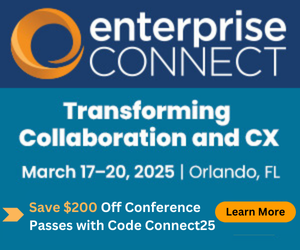AI-Powered Meeting Tech: Cost Cutter or Superfluous Expense?AI-Powered Meeting Tech: Cost Cutter or Superfluous Expense?
AI-powered meeting technology could reshape collaboration -- but careful analysis and planning are required to ensure they're worth the price.
February 3, 2025

AI-powered meeting technology is reshaping the way organizations collaborate, offering tools that range from background noise suppression to automated meeting transcription and translation.
With remote and hybrid work now permanent fixtures, businesses are exploring how AI can enhance both virtual and physical meeting spaces—but careful analysis and planning is required to ensure investment in these features is worth the price.
Will McKeon-White, an analyst at Forrester said early AI innovations, such as sound cleaning, voice isolation, and background blurring, were critical in making virtual collaboration viable during the pandemic.
These tools addressed issues like background noise and poor audio quality, which could derail meetings.
“These basic AI-based experience improvements became essential in early 2020 and remain foundational,” he said.
More recent advancements, including automated transcription and note summarization, are showing promise, although they still have limitations, such as accuracy gaps.
From McKeon-White’s perspective, a standout innovation is real-time translation, enabling participants to communicate seamlessly across multiple languages.
“The real breakthrough lies in expanding the number of language pairs that platforms can handle simultaneously, making this a game-changer for multinational organizations,” he said.
Deciding which AI features to implement should involve collaboration between platform owners, IT leaders, and senior management.
Basic capabilities like noise suppression may require minimal configuration, but integrating advanced features, such as those leveraging employee data or external databases, demands broader stakeholder involvement.
“If additional integrations or configurations are needed, the responsibility expands to multiple teams,” McKeon-White said, emphasizing the importance of cross-departmental coordination in AI adoption.
Assessing Value with KPIs
While the potential value of these features is clear, businesses must carefully assess whether they are worth the investment.
McKeon-White pointed out that many AI features, like automated translation, are now bundled into affordable pricing tiers offered by major platforms such as Microsoft Teams.
However, organizations must account for more than just the upfront cost.
“The more advanced the AI capability, the more work it requires from the purchasing organization to configure it effectively,” he said.
This added complexity often leads to unrealistic expectations about AI’s out-of-the-box functionality.
Dan Root, head of global strategic alliances at Barco ClickShare, said once enabled, AI-powered meeting spaces can be measured against the traditional IT KPIs around time-to-recognition, time-to-resolution, and frequency of tickets.
“In many cases, an AI-powered meeting room will be able to self-identify an issue within the room, determine the best set of steps for resolution, and complete the required steps and sub-tasks necessary to bring the room back online prior to people entering the space,” he said.
He admitted this notion of ‘self-healing’ spaces may sound sci-fi at the moment, but Microsoft has spoken about this concept during Satya’s Ignite keynote, as multiple vendors are bringing this to reality.
If there is a physical issue within a space, the AI-agent tasked to the space will notify the proper resource while also providing the steps to resolve the issue.
“These capabilities alone will significantly reduce the risk of walking into unprepared or broken meeting rooms,” Root said.
Through tools like Microsoft Teams Meeting Facilitator, meeting rooms can leverage the help of AI agents within the space to ensure notes are taken, tasks are assigned, and in-room speakers are properly attributed.
“While this technology is still in its infancy stage, soon spaces will be able to curate the experience around your personal preferences and drastically reduce moments of frustration within the workplace,” he added.
During learning periods when introducing or when only part of the team is enabled with a new tool it is very possible to slow down productivity and collaboration within the meeting space.
“It’s important that the team understands the tools that are available to them and how best to leverage them daily,” Root said.
Clear Goals, Swift Onboarding
From his perspective, simplicity is key for adoption, and standardizing the experience across spaces will further reduce onboarding time across the organization.
While the cost of AI-powered tools like Microsoft Copilot can seem expensive at the outset, the cost of some employees having these tools while others do not can slow progress tremendously.
“The result is some contributors being able to work in a completely different manner than others, creating an unequal workload for tasks and unfair expectations across the team,” he said.
While it may make sense on paper to enable ‘just the management’, the resulting shift in expectations from management to the employees may lead to an erosion of trust.
Root said to combat these issues, it’s important to have a clear plan around “who” and “when” AI-powered tools are enabled within the team, ensure that all contributors on a team have access to the same set of tools, and align the meeting spaces with the same tools to ensure a smooth adoption and utilization.
“In every instance, IT teams need to understand the teams they’re supporting,” he said.
McKeon-White added as organizations evaluate these technologies, the key is to invest not only in the tools themselves but also in the time and expertise needed to ensure their successful deployment.
“AI isn’t self-learning or magical—it requires effort and alignment to make it work the way you want,” he explained.
About the Author
You May Also Like





